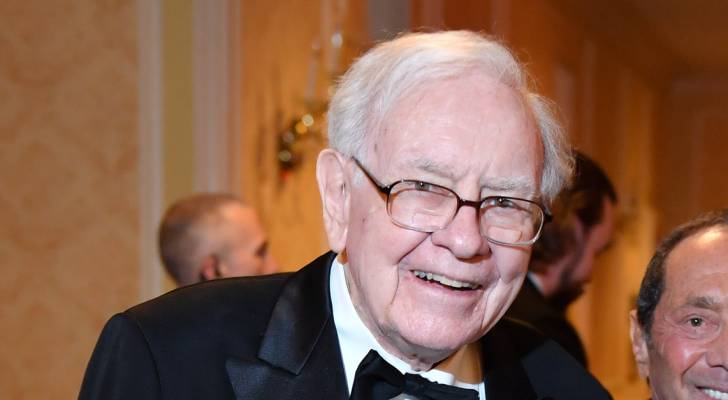We adhere to strict standards of editorial integrity to help you make decisions with confidence. Some or all links contained within this article are paid links.
The U.S. stock market has taken a beating as Trump’s tariff-fueled sell-offs continue to rattle investors. But according to one prominent bear, the worst is yet to come.
Mark Spitznagel, founder and chief investment officer of Universa Investments, warned in commentary to MarketWatch that a historic collapse may be looming.
"I expect an 80% crash when this is over. I just don’t think this is it. This is a trap," he said on April 7, days before Trump announced a 90-day pause on his plan to hike tariffs on most countries.
Don’t miss
- I’m 49 years old and have nothing saved for retirement — what should I do? Don’t panic. Here are 5 of the easiest ways you can catch up (and fast)
- Gain potential quarterly income through this $1B private real estate fund — even if you’re not a millionaire. Here’s how to get started with as little as $10
- Car insurance premiums could spike 8% by the end of 2025 — thanks to tariffs on car imports and auto parts from Canada and Mexico. But here’s how 2 minutes can save you hundreds of dollars right now
The stock market recovered some losses on that announcement, but it’s still a chilling forecast from Spitznagel. The S&P 500 is down roughly 7% year to date — enough to shake investor confidence — yet Spitznagel suggests that could be just the beginning of a much steeper fall.
“This is another selloff to shake people out. This isn’t Armageddon. That time will come as the bubble bursts,” he said.
Spitznagel is no stranger to market mayhem. He gained notoriety during the 2020 COVID crash, when Universa’s flagship “Black Swan Protection Protocol” fund posted an eye-popping 4,144% return in the first quarter of that year.
Markets are inherently volatile. Whether or not you buy into Spitznagel’s outlook, it might be a good time to consider how to diversify beyond traditional stocks. Here are three simple ways to start.
‘A very effective diversifier’ for bad times
Ray Dalio, founder of the world’s largest hedge fund, Bridgewater Associates, recently underscored the importance of diversification — and the enduring value of one classic asset.
“People don’t have, typically, an adequate amount of gold in their portfolio,” he said in a February interview with CNBC. “When bad times come, gold is a very effective diversifier.” He suggests having 10-15% of a portfolio invested in gold.
Gold is considered a go-to safe haven. It can’t be printed out of thin air like fiat money, and because it’s not tied to any single currency or economy, investors often flock to it during periods of economic turmoil or geopolitical uncertainty, driving up its value.
Over the past 12 months, gold prices have surged by more than 35%.
For those looking to capitalize on gold’s potential while also securing tax advantages, one option is opening a gold IRA with the help of Priority Gold.
Gold IRAs allow investors to hold physical gold or gold-related assets within a retirement account, thereby combining the tax advantages of an IRA with the protective benefits of investing in gold, making it an option for those seeking to ensure their retirement funds are well-shielded against economic uncertainties. Some of the drawbacks may include storage and insurance costs eating into returns and low liquidity.
When you make a qualifying purchase with Priority Gold, you can receive up to $10,000 in precious metals for free.
Read more: Want an extra $1,300,000 when you retire? Dave Ramsey says this 7-step plan ‘works every single time’ to kill debt, get rich in America — and that ‘anyone’ can do it
Income, even in a down market
Like stocks, real estate has its cycles, but it doesn’t rely on a booming market to generate returns.
Even during a recession, high quality, essential real estate can continue to produce passive income through rent. In other words, you don’t have to wait for prices to rise to see a payoff — the asset itself can work for you.
It’s also a time-tested hedge against inflation. As the cost of materials, labor, and land rises, property values often increase as well. At the same time, rental income tends to climb, giving landlords a revenue stream that adjusts with inflation.
Traditionally, investing in real estate meant buying property and becoming a landlord. But for everyday investors who want to avoid the need for a hefty down payment or the burden of property management, crowdfunding platforms like Arrived offer an easier way to get exposure to this income-generating asset class. However, average investors should make sure they understand the risks involved with real estate crowdfunding, like illiquidity and no guarantee of returns.
With Arrived, you can invest in shares of rental homes with as little as $100, all without the hassle of mowing lawns, fixing leaky faucets or handling difficult tenants.
The process is simple: browse a curated selection of homes that have been vetted for their appreciation and income potential. Once you find a property you like, you can select the number of shares you’d like to purchase.
Another option is First National Realty Partners (FNRP), which allows accredited investors to diversify their portfolio through grocery-anchored commercial properties, without taking on the responsibilities of being a landlord.
With a minimum investment of $50,000, investors can own a share of properties leased by national brands like Whole Foods, Kroger and Walmart, which provide essential goods to their communities. Thanks to Triple Net (NNN) leases, accredited investors are able to invest in these properties without worrying about tenant costs cutting into their potential returns.
Simply answer a few questions – including how much you would like to invest – to start browsing their full list of available properties.
A finer alternative
It’s easy to see why great works of art tend to appreciate over time. Supply is limited and many famous pieces have already been snatched up by museums and collectors.
Art also has a low correlation with stocks and bonds, which helps with diversification. But it’s not without drawbacks: fine art is an illiquid, high-risk asset whose value can be influenced by shifting tastes, trends and the art world’s inner circle. It also requires proper storage, insurance and care — adding to the cost and complexity.
In 2022, a collection of art owned by the late Microsoft co-founder Paul Allen sold for $1.5 billion at Christie’s New York, making it the most valuable collection in auction history.
Investing in art was traditionally a privilege reserved for the ultra-wealthy.
Now, that’s changed with Masterworks — a platform for investing in shares of blue-chip artwork by renowned artists, including Pablo Picasso, Jean-Michel Basquiat and Banksy. They charge a 1.5% annual management fee and receive 20% of the profit when a painting sells.
It’s easy to use, and there have been 23 successful exits to date that have distributed roughly $61 million back to investors.
Simply browse their impressive portfolio of paintings and choose how many shares you’d like to buy. Masterworks will handle all the details, making high-end art investments both accessible and effortless.
New offerings have sold out in minutes, but you can skip their waitlist here. See important Regulation A disclosures at Masterworks.com/cd.
What to read next
- Thanks to Jeff Bezos, you can now become a landlord for as little as $100 — and no, you don’t have to deal with tenants or fix freezers. Here’s how
- Here are 5 ‘must have’ items that Americans (almost) always overpay for — and very quickly regret. How many are hurting you?
- Trump warns his tariffs will spark a ‘disturbance’ in America — use this 1 dead-simple move to help shockproof your retirement plans ASAP
This article provides information only and should not be construed as advice. It is provided without warranty of any kind.


